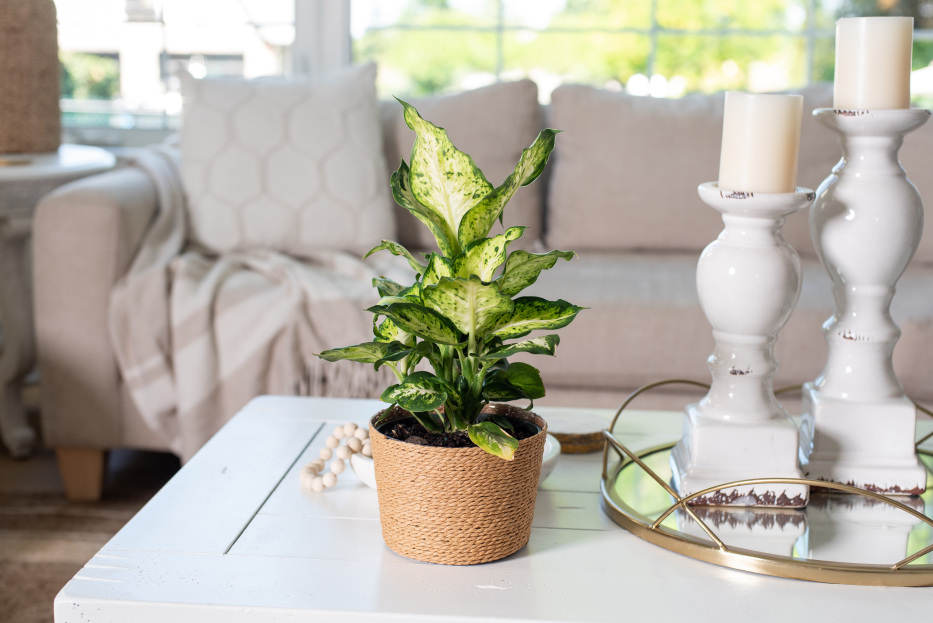
Sometimes called "Dumb Cane" due to the numbing effect caused by ingesting its leaves (not recommended), the Dieffenbachia is a smart choice for any space due to its bold patterns and air-purifying abilities. Some examples of Dieffenbachia are Dieffenbachia Camille and Dieffenbachia Compacta. Just as its alternate name suggests, the dumb cane is listed as toxic to cats and dogs, so be sure to keep this plant far away from any curious pets or children as if ingested can cause stomach irritation.
Dieffenbachia plants thrive best as an indoor houseplant in bright in-direct sunlight. Plant them in a well-draining soil mix that contains a high peat content. As a tropical plant, these plants do best when kept in high humidity.
Dieffenbachia plants are popular indoor houseplants because of their ability to do well in shady and lower light conditions. However, they do thrive with very bright light during the winter season. During its grow season (Spring/Summer) the Dieffenbachia prefers dappled in-direct sunlight. The plant is known to favour the side that is facing the light – so a good tip would be to rotate the plant regularly so that all sides of the plant can benefit from the sunlight.

Using a well-draining & high peat-based soil mix will ensure that the plants roots will not develop root rot or damage the roots. Keep the soil moist but not oversaturated and this will ensure that your Dieffenbachia stays looking its best!
During its grow season – Dieffenbachia plants like regular moisture and do not like their soil to dry out fully. In their growing season (Spring/Summer) these plants like to be watered more frequently. Ensure that only the top few inches of soil dry out between waterings. If you let the whole pot of soil dry out, then your plant can be at risk for dying early.
Plants that grow very quickly and use a lot of energy are the kinds that benefit from regular fertilization. That’s why the Dieffenbachia is a plant that should be fertilized every 4-6 weeks during its growing season. By doing this you provide your plant with nutrients to help it grow quickly and stay healthy. Using a diluted liquid fertilizer is the best way to help your Dieffenbachia grow.

Dieffenbachia plants do best in warmer and more humid conditions. The ideal temperature range to keep these plants in is between 65- and 75-degrees F. If the temperature drops below this threshold or exposed to cold drafts of air – it is likely to lose leaves or deteriorate quickly. Keeping this plant in a warm humid environment is sure to keep it happy. You can also help increase the humidity by lightly misting your plant.
The easiest way to propagate your Dieffenbachia is through root cuttings, tip cuttings or stem cuttings. Plant these pieces into the right soil mix and provide them with bright in-direct sunlight and adequate water and they will eventually produce roots and eventually an entirely new plant!
Using a sharp sterile knife or scissors, cut the tips from the end of the plant or look for shoots coming from the main stem to cut off and re plant.
Fill your pot with a well-draining potting mix and water generously until the excess water comes out of the drainage holes. Then you can place your cutting into this soil mix. Ensure that stems tip is the only part in the soil and standing up straight.
Keep these cuttings moist but not overly saturated and place them in their planter in a warm and dim spot that still receives in-direct sunlight. Depending on the type of dieffenbachia you are using – you should see new roots within 3 – 8 weeks.

Dieffenbachia plants often need annual repotting. Keep an eye out for signs of plant stress – such as roots emerging from the surface, falling leaves or excessive crowding of its leaves. These are all indicators that your plant may need to be repotted.
To repot your plant, carefully remove it from its current pot, remove all old soil and place it into a larger pot with fresh moist soil. After repotting your Dieffenbachia, give it some time to adjust to its new setting before resuming a regular routine.
Dieffenbachia plants are usually issue-free, but like many other indoor plants they are susceptible to spider mites and other insects. Check out our beginner plant guide where we go over some common pests that you may encounter.
Discoloration of leaves is most commonly due to overwatering or not evenly watering. Browning tips can be an indicator of your soil not being evenly watered. Ensure when watering that the soil is evenly moist, and that the roots get the water that they need. Over-watering can quickly lead to the death of your plant. Make sure that your pot has a drainage hole at the bottom to let excess water escape, or remove the plant from its overpot (keeping it in its recyclable plastic grower pot) and water over a sink or basin to let the excess water drain away.

Drooping leaves can be an indicator of your plant not receiving the amount of water it needs. When the top few inches of your soil feel dry to the touch then it's time to give your plant a good watering. If the soil is moist however and your leaves are still drooping, then you may be overwatering your plant. Reduce the frequency of your waterings or saturate the soil a little less to help reduce this excess water.